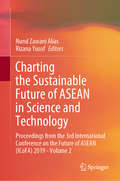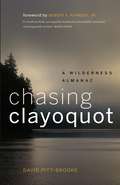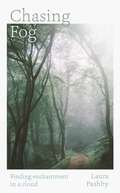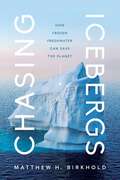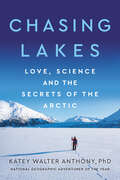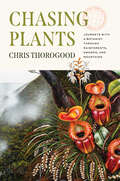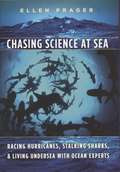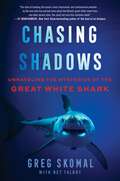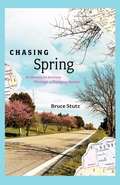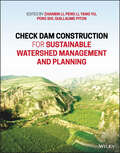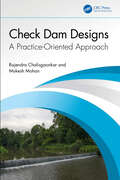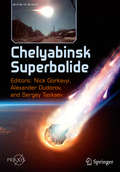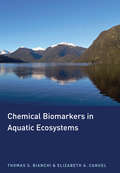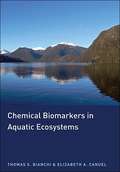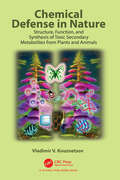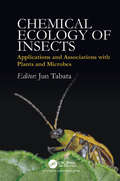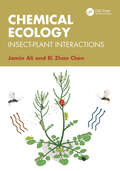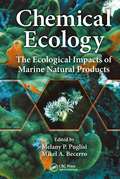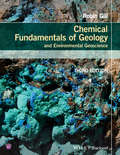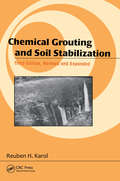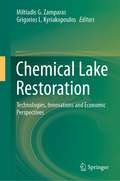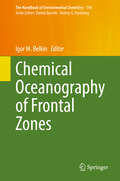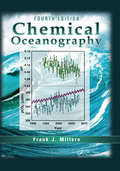- Table View
- List View
Charting the Sustainable Future of ASEAN in Science and Technology: Proceedings from the 3rd International Conference on the Future of ASEAN (ICoFA) 2019 - Volume 2
by Nurul Zawani Alias Rizana YusofThis book showcases selected conference papers addressing the sustainable future of ASEAN from the perspectives of science and technology disciplines. In addressing the 17 Sustainable Developments Goals (SDGs) envisioned by the United Nations in the domains of environment, health and well-being, posing potential means of reducing inequalities globally, the authors target specific issues and challenges confronting the fast-growing region of ASEAN and present suggestions for co-operation and commitment from governments, non-governmental organisations (NGOs) and society at large, in line with the ASEAN Vision 2020. Papers are selected from the 3rd International Conference on the Future of ASEAN (ICoFA) 2019, organised by Universiti Teknologi MARA in Malaysia, whose conference theme “Charting the Sustainable Future of ASEAN” enables intellectual discourse on sustainability issues from science and technology, as well as business and the social sciences. The selection of papers is published in two books, comprised of scholarly and practical insights on sustainability in ASEAN. This book from science and technology scholars is of interest to researchers and policymakers interested in sustainability developments in the ASEAN region.
Charting the World: Geography and Maps from Cave Paintings to GPS with 21 Activities (For Kids series)
by Richard PanchykMaps have been a part of human culture since the days of scratching on cave walls, and this richly illustrated history chronicles the road from simple diagrams used to avoid danger to the complex, navigational charts used today. Displaying an array of historic atlases and a variety of cartography styles, this book allows young readers to test their map-reading skills while discovering the intricate beauty and the wealth of information held within. Geographical concepts are spotlighted through an assortment of guided activities--including finding the elevation of hills, plotting a course with a magnetic compass, creating three-dimensional land models using a contour map, and performing a plot survey. Drawing the conclusion that the study of geography and maps is crucial to understanding an ever-changing planet, this handbook discloses the ways in which technological advances in cartography can further discussions on climate change, warfare, environmental conservation, population growth, and other timely topics.
Chasing Clayoquot
by Robert F. Kennedy Jr. David Pitt-BrookeFirst published in 2004, and now with a new introduction by the author and a foreword by Robert F. Kennedy Jr., this book of natural history, environmentalism, and politics explores one of the Earth's last primeval places: Clayoquot Sound. Pitt-Brooke takes the reader on 12 journeys, one for each month of the year. Each journey covers the outstanding natural event of that season, such as whale-watching in April, shorebird migration in May, and the salmon spawn in October.
Chasing Fog: Finding Enchantment in a Cloud
by Laura PashbyAt first, I didn&’t find fog – fog found me. Liminal, transformative and increasingly elusive – far from a simple cloud of water droplets, fog is a state of mind. As mist drifted through a copse of trees, turning a familiar place strange and otherworldly, Laura Pashby snapped a photograph and an obsession began. Pashby hunts for fog, walks and swims in it, explores its often pivotal role in literature, mythology and history, as well as its environmental significance. There has been a 50 per cent drop in 'fog events' in the past fifty years, fog is drifting away without us noticing and the ecological impact could be calamitous. As she journeys to the foggiest places she can find, Pashby immerses herself in Dartmoor&’s dangerous fog, searches for the Scottish haar, experiences Venice&’s magical mist, tell us the myths behind the River Severn&’s fog and the shipwrecks it hides. It&’s easy to get lost in fog, but sometimes it&’s where imperceptible things can be found, including in ourselves. Chasing Fog is a captivating meditation on fog and mist, a love song to weather and nature&’s power to transform.
Chasing Icebergs: How Frozen Freshwater Can Save the Planet
by Matthew H. BirkholdA deeply intelligent and engrossing narrative that will transform our relationship with water and how we view climate change.The global water crisis is upon us. 1 in 3 people do not have access to safe drinking water; nearly 1 million people die each year as a result. Even in places with adequate freshwater, pollution and poor infrastructure have left residents without basic water security. Luckily, there is a solution to this crisis where we least expect it. Icebergs—frozen mountains of freshwater—are more than a symbol of climate change. In his spellbinding Chasing Icebergs, Matthew Birkhold argues the glistening leviathans of the ocean may very well hold the key to saving the planet. Harvesting icebergs for drinking water is not a new idea. But for the first time in human history, doing so on a massive global scale is both increasingly feasible and necessary for our survival. Chasing Icebergs delivers a kaleidoscopic history of humans&’ relationship with icebergs, and offers an urgent assessment of the technological, cultural, and legal obstacles we must overcome to harness this freshwater resource. Birkhold takes readers around the globe, introducing them to a colorful cast of characters with wildly different ideas about how (and if) humans should use icebergs. Sturdy bureaucrats committed to avoiding another Titanic square off against &“iceberg cowboys&” who wrangle the frozen beasts for profit. Entrepreneurs selling luxury iceberg water for an eye-popping price clash with fearless humanitarians trying to tow icebergs across the globe to eradicate water shortages. Along the way, we meet some of the world&’s most renowned scientists to determine how industrial-scale iceberg harvesting could affect the oceans and the poles. And we see firsthand the looming conflict between Indigenous peoples like the Greenlandic Inuit with claims to icebergs and the private corporations that stand to reap massive profits. As Birkhold shepherds readers from Connecticut to South Africa, from Newfoundland to Norway, to Greenland and beyond, he unfurls a visionary argument for cooperation over conflict. It&’s not too late for icebergs to save humanity. But we must act fast to form a coalition of scientists, visionaries, engineers, lawyers and diplomats to ensure that the &“Cold Rush&” doesn&’t become a free-for-all.
Chasing Lakes: Love, Science, and the Secrets of the Arctic
by Katey Walter AnthonyAn aquatic ecologist and permafrost scientist recalls her captivating adventures across the Arctic studying climate change, her quest to find belonging and family, and her journey of faith in a world of science in this poignant, eye-opening, and hopeful memoir in the spirit of Lab Girl, Educated, and Finding the Mother Tree.Katey Walter Anthony’s enchantment with lakes began when she was growing up amid the Sierra Nevada mountains. Today, her love for these bodies of water have taken her to the deepest reaches of Alaska and Siberia, where she is undertaking pioneering research on methane emissions. Chasing Lakes is her story: one-part adventure—complete with shipwrecks and treacherous treks through Arctic storms by helicopter, snowmobile, and foot to measure greenhouse gases—part coming-of-age tale, as she searches for belonging in the wake of a broken childhood, and part spiritual quest to find a wholeness science cannot fill.Somewhere between the remote, frozen landscapes of Siberia and her rough cabin in Alaska, she discovers her spiritual and emotional home when she meets Peter, a bright and humble Minnesota farmer who reinvigorates her faith and helps ground her. Yet finding love and fulfillment brings its own challenges. The closer she gets to having the family she’s always wanted, the further she’s pushed from the important field work that is her passion.Chasing Lakes is a chronicle of a woman seeking truth, adventure, scientific discovery, family, love, and grace. Both an eye-opening look from the frontlines of the climate crisis and an intimate portrait of a brilliant scientist, Chasing Lakes is memoir writing at its finest: beautiful, complex, revelatory, and moving.
Chasing Plants: Journeys with a Botanist through Rainforests, Swamps, and Mountains
by Chris ThorogoodA New Scientist Best Book of the Year From an acclaimed botanist and artist, a thrilling and beautifully illustrated expedition around the globe in search of the world’s most extraordinary plants. After making a strange discovery on a childhood trip to Ikea—a stand of sap-sucking, leafless broomrapes, stealing nutrients from their neighbors’ roots—Chris Thorogood dreamed of becoming a botanist and would stop at nothing to feed his growing addiction to plants. In his hair-raising adventures across Europe, Africa, the Middle East, and Asia, Thorogood treads a death-defying path over cliffs, up erupting volcanoes, through typhoons, and out into the very heart of the world’s vast, green wilderness. Along the way, he encounters pitcher plants, irises, and orchids more heart-piercingly beautiful than could ever be imagined. But with Thorogood as our guide in Chasing Plants, we not only imagine: we see. An internationally acclaimed botanical illustrator, Thorogood conjures his adventures spent seed-collecting and conserving plants around the world back to life in his electric paintings, which feature throughout the book. They bring plants out of the shadows, challenging us to see their intrigue and their character, and helping us to understand why plant species must be protected. To join Thorogood in his wild adventures is to be cast under his green spell: readers will never think of plants the same way again.
Chasing Science at Sea: Racing Hurricanes, Stalking Sharks, and Living Undersea with Ocean Experts
by Ellen PragerTo the average office-dweller, marine scientists seem to have the good life: cruising at sea for weeks at a time, swimming in warm coastal waters, living in tropical paradises. But ocean scientists who go to sea will tell you that it is no vacation. Creature comforts are few and the obstacles seemingly insurmountable, yet an abundance of wonder and discovery still awaits those who take to the ocean. With passion and wit, well-known marine scientist Ellen Prager shares her stories as well as those of her colleagues, revealing that in the field ingenuity and a good sense of humor are as essential as water, sunblock, and a GPS. Serendipity is invaluable, and while collecting data is the goal, sometimes just getting back to shore means success. But despite the physical hardship and emotional duress that come with the work, optimism and adventure prompt a particularly hardy species of scientist to return again and again to the sea. Filled with firsthand accounts of the challenges and triumphs of dealing with the extreme forces of nature and the unpredictable world of the ocean, "Chasing Science at Sea" is a unique glimpse below the water line at what it is like and why it is important to study, explore, and spend time in one of our planet's most fascinating and foreign environments.
Chasing Shadows: My Life Tracking the Great White Shark
by Greg Skomal Ret Talbot“At last: the story of tracking the ocean’s most charismatic and controversial predator, compellingly told by the man who has learned more about the Atlantic great white shark than any other person alive. You must not miss this fantastic book!” —Sy Montgomery, New York Times bestselling author of The Soul of an OctopusDr. Greg Skomal, one of the leading great white shark experts in the country, reveals the true nature of these mysterious apex predators, as well as the fascinating story behind their history and startling resurgence With its quaint villages, local restaurants serving up lobster rolls, and miles and miles of warm, sandy beaches, Cape Cod, Massachusetts, is famous for being America’s carefree seaside getaway. But in August 2012, the first confirmed white shark attack in almost eighty years occurred in the region. As shark sightings quickly began to increase on Cape Cod and elsewhere, and large beachside billboards warning about the growing shark population became a common sight, a boogie boarder died after being attacked by a great white shark in Cape Cod’s shallow waters. What had changed to cause news of human-shark interactions to go from being a rarity to being the new normal? As some citizens called for shark culls, nets, drone surveillance, and other extreme solutions, interactions between local residents and scientists, politicians, and those responsible for public safety became tense and frantic. Dr. Greg Skomal, a shark biologist whose lifelong passion has been to gain a more refined understanding of great white sharks, was at the center of it all. This is the story of the great white shark’s return to the eastern seaboard, told through the life of the scientist who found himself in the oftentimes thankless position of having to balance conservation efforts and the drive to do important science with panic and fear in the court of public opinion. Greg has spent decades on a quest to tag, track, and demystify this animal, using every high- and low-tech method at his disposal, including those he invented, and he frequently comes face-to-face with these shadows of the deep. He leaves no stone unturned in his pursuit of the secrets behind the largely unknown lives of these charismatic creatures and in his duty to solve the intricate puzzle of how humans can coexist alongside them. Chasing Shadows is a too-rare conservation success story about restoring an apex predator to an ecosystem that provides a profound, new understanding of a beast so notoriously fierce that it’s nearly impossible to imagine how vulnerable it truly is.
Chasing Spring: An American Journey Through a Changing Season
by Bruce StutzIn the tradition of Blue Highways and Silent Spring, Chasing Spring follows nature's season of renewal even as it shows how the delicate mechanisms of spring are increasingly endangered by climate change. Seeking to revive his body and soul following heart surgery, acclaimed nature writer Bruce Stutz set out on a three-month journey through the unfolding of an American spring. Driving across the country in a twenty-year-old Chevy sedan, Stutz shows readers that spring is not so much a progression as an arousal; each added minute of the lengthening days and lingering sun brings yet another transformation in the greening landscape as well as in the human spirit. Beginning with the season's southernmost stirrings along the Gulf of Mexico, Stutz sees the first blooms and partakes in the season's festivals -- celebrations with ancient origins that still speak to our wonder at nature's annual rebirth. He follows the migrations of birds northward, the return of life to the forests, and the quickening of snowmelt in the Rockies. He moves across the southern desert, encountering the explosion of cacti and wildflowers and the violence of tornadoes on the drought-stricken Great Plains. He then travels north through the national parks of the West, finally celebrating his journey's end by basking at the solstice amid the beauty of the Alaskan Arctic's twenty-four hours of daylight. Along the way, he accompanies scientists into the field to study the season's changes and meets farmers, Arctic natives, and even migrant mushroom pickers whose livelihoods depend on the coming of spring. In each location, as he observes the sensitive interplay of light and warmth that draws animals, plants, water, and even the soil itself into the biological ballet that makes for the profound stirring we call spring, he also finds that climate change now threatens the basic processes of nature. A moving and thought-provoking record of the year¹s most invigorating season, Chasing Spring is a timely reminder that as trees bud and flowers bloom, the human spirit reawakens as well. Anyone who has ever marveled at spring¹s wondrous transformations?from a first garden blossom to a world in full flower?will find in Chasing Spring a journey to savor.
Check Dam Construction for Sustainable Watershed Management and Planning
by Peng Shi Peng Li Yang Yu Zhanbin Li Guillaume PitonCHECK DAM CONSTRUCTION FOR SUSTAINABLE WATERSHED MANAGEMENT AND PLANNING Authoritative and comprehensive reference on the potential for watershed development through the use of check dams Check Dam Construction for Sustainable Watershed Management and Planning summarizes current knowledge of check dams as key soil and water conservation structures in some of the most sensitive and vulnerable ecosystems in the world, as exemplified by the Mediterranean area and the Chinese Loess Plateau, providing detailed information on check dam design and watershed planning, the use of advanced modeling techniques, challenges in dam construction and how to overcome them. The work integrates decades of research in the field of soil and water conservation and gully management, including advanced studies in check dam construction and watershed management. It also covers important new techniques and methods, such as hydrological modeling, isotope tracing, and more. To aid in reader comprehension, the five highly qualified editors have divided the work into three distinct sections. Sections I and II focus on the experience gained from the erosion hotspots in the Chinese Loess Plateau, whereas Section III expands the scope to other regions with different functions for check dams, including headwater ecosystems and alpine environments. Sample topics covered in Check Dam Construction for Sustainable Watershed Management and Planning include: The regulating effect of check dam systems on sediment redistribution and the formation and development of dam systems in small watersheds Water and soil conservation made possible by check dam construction and sediment source analysis of water-sediment retarding effects of check dams The regulation of check dam systems on the erosion dynamic process and the mechanism of erosion reduction by check dams Flood control risk assessment on warping dam systems and the development and utilization model of check dam systems With its systematic coverage of all aspects of dam construction and maintenance, Check Dam Construction for Sustainable Watershed Management and Planning supports decision making by local authorities and can also be used as a professional guide for ecologists, hydrologists, and water resource managers.
Check Dam Designs: A Practice-Oriented Approach
by Rajendra Chalisgaonkar Mukesh MohanCheck dams are small barriers built across the direction of water flow on shallow rivers and streams for the purpose of water harvesting. This book is a review of basic principles and practice-oriented approaches for check dam designs. It offers a hands-on approach with a strong, practical bias helpful in solving problems that are likely to be encountered in real-life field situations. It has been divided into nine chapters dealing with design details for gabion, masonry, concrete, and rubber check dams, including briefs about topographical surveys and geotechnical and hydrological investigations.Features: Gives insight into the principles of design and construction of check dams. Includes data assumptions and design principles along with design philosophy. Discusses design of gabion, masonry, and concrete check dams. Contains illustrative examples along with 20 engineering drawings and 140 quick solution tables for design of gabion, masonry, and concrete check dams. Explores easy-to-use tables for design of masonry and concrete retaining walls. This book is aimed at professionals, students, researchers, and practitioners in civil engineering, hydrology, and water conservation.
Chelyabinsk Superbolide (Springer Praxis Books)
by Nick Gorkavyi Alexander Dudorov Sergey TaskaevOn February 15, 2013, the Chelyabinsk meteor sailed over Russian skies in a streak of light that was momentarily brighter than the Sun. The remarkable event and its subsequent shock wave were witnessed and documented by countless local residents, launching a widespread scientific expedition to gather and study the remaining meteoritic fragments.This book chronicles Chelyabinsk’s tale of recovery and discovery from the minds of many of the scientists who studied the superbolide, leading field experiments and collecting meteorites and meteorite dust across the region. The Chelyabinsk superbolide is a complex and multi-aspect phenomenon. The book not only presents the results of the scientific research but also details the firsthand experiences of those involved in such efforts, providing readers with a unique opportunity to look at the "inner workings" of science that are seldom shown to the public.Over the course of their studies, the scientists collected over 200 photographs and a dozen video recordings taken by nearly 40 different eyewitnesses. Many of those never-before-published illustrations and photos can be found in full color in the pages of this book.
Chemical Biomarkers in Aquatic Ecosystems
by Thomas S. Bianchi Elizabeth A. CanuelThis textbook provides a unique and thorough look at the application of chemical biomarkers to aquatic ecosystems. Defining a chemical biomarker as a compound that can be linked to particular sources of organic matter identified in the sediment record, the book indicates that the application of these biomarkers for an understanding of aquatic ecosystems consists of a biogeochemical approach that has been quite successful but underused. This book offers a wide-ranging guide to the broad diversity of these chemical biomarkers, is the first to be structured around the compounds themselves, and examines them in a connected and comprehensive way. This timely book is appropriate for advanced undergraduate and graduate students seeking training in this area; researchers in biochemistry, organic geochemistry, and biogeochemistry; researchers working on aspects of organic cycling in aquatic ecosystems; and paleoceanographers, petroleum geologists, and ecologists. Provides a guide to the broad diversity of chemical biomarkers in aquatic environments The first textbook to be structured around the compounds themselves Describes the structure, biochemical synthesis, analysis, and reactivity of each class of biomarkers Offers a selection of relevant applications to aquatic systems, including lakes, rivers, estuaries, oceans, and paleoenvironments Demonstrates the utility of using organic molecules as tracers of processes occurring in aquatic ecosystems, both modern and ancient
Chemical Biomarkers in Aquatic Ecosystems
by Thomas S. BianchiThis textbook provides a unique and thorough look at the application of chemical biomarkers to aquatic ecosystems. Defining a chemical biomarker as a compound that can be linked to particular sources of organic matter identified in the sediment record, the book indicates that the application of these biomarkers for an understanding of aquatic ecosystems consists of a biogeochemical approach that has been quite successful but underused. This book offers a wide-ranging guide to the broad diversity of these chemical biomarkers, is the first to be structured around the compounds themselves, and examines them in a connected and comprehensive way. This timely book is appropriate for advanced undergraduate and graduate students seeking training in this area; researchers in biochemistry, organic geochemistry, and biogeochemistry; researchers working on aspects of organic cycling in aquatic ecosystems; and paleoceanographers, petroleum geologists, and ecologists. Provides a guide to the broad diversity of chemical biomarkers in aquatic environmentsThe first textbook to be structured around the compounds themselvesDescribes the structure, biochemical synthesis, analysis, and reactivity of each class of biomarkersOffers a selection of relevant applications to aquatic systems, including lakes, rivers, estuaries, oceans, and paleoenvironmentsDemonstrates the utility of using organic molecules as tracers of processes occurring in aquatic ecosystems, both modern and ancient
Chemical Defense in Nature: Structure, Function, and Synthesis of Toxic Secondary Metabolites from Plants and Animals
by Vladimir V. KouznetsovThe book examines biological processes vital for organism survival through a chemical lens. Integrating core organic chemistry concepts, such as structural analysis and synthesis, explores how plants and animals produce and utilize toxic organic molecules for growth, survival, and reproduction.The book focuses on the intricate structures, vital functions, and synthesis pathways of toxic secondary metabolites from plants and animals, illustrating toxic substances' intricate chemical relationships and biological significance. The book addresses the following main questions: Why do animals and plants accumulate these toxic substances? What structures do these compounds have? What effects can they have on man? Can they be prepared in the laboratory and used for medicinal purposes?This book delves into the fascinating world of toxic secondary metabolites in plants and animals, bridging chemistry and biology to unravel their roles in survival. With an interdisciplinary approach, it is a valuable resource for researchers, students, and professionals in phytochemistry, organic chemistry, and medical sciences.
Chemical Ecology of Insects: Applications and Associations with Plants and Microbes
by Jun TabataInsects have evolved very unique and interesting tactics using chemical signals to survive. Chemical ecology illustrates the working of the biological network by means of chemical analyses. Recent advances in analytical technology have opened the way to a better understanding of the more complicated and abyssal interactions of insects with other organisms including plants and microbes. This book covers recent research on insects and chemical communications and presents the current status about challenges faced by chemical ecologists for the management of pests in agriculture and human health.
Chemical Ecology: Insect-Plant Interactions
by Jamin Ali Ri Zhao ChenThis textbook provides a comprehensive overview of the principles, methods and applications of chemical ecology, covering such topics as chemical signalling, predator–prey interactions, host plant selection and chemical defence. The book takes the reader through the historical development of the discipline to current state-of-the-art research, delving into recent findings on the role of chemical ecology in conservation and management and exploring how the field may contribute to future innovations in ecological science. A chapter is dedicated to the techniques that have been used in chemical ecology and some success stories.Chemical Ecology: Insect-Plant Interactions is an important resource for advanced undergraduates and postgraduate researchers as well as practitioners in this interdisciplinary field. The book’s layout aligns with the curriculum of chemical-ecology-related disciplines, progressing from basic fundamental principles to a more advanced level. Those studying and researching in ecology, entomology, plant biology and biochemistry will find it invaluable as well as those practising in areas such as agriculture, forestry and pest management.
Chemical Ecology: The Ecological Impacts of Marine Natural Products
by Melany P. Puglisi Mikel A. BecerroDuring the past 20 years, marine chemical ecology has emerged as a respected field of study providing a better understanding of the role natural products play in organisms and their environments. Ample data in this book advocates the conservation of marine environments for future drug discovery efforts while sustaining their overall health. Marine chemical ecology has expanded to include research in the areas of predator–prey interactions, marine microbial chemical ecology, and seasonal and geographical distribution of marine natural products.
Chemical Fundamentals of Geology and Environmental Geoscience
by Robin GillChemical principles are fundamental to the Earth sciences, and geoscience students increasingly require a firm grasp of basic chemistry to succeed in their studies. The enlarged third edition of this highly regarded textbook introduces the student to such 'geo-relevant' chemistry, presented in the same lucid and accessible style as earlier editions, but the new edition has been strengthened in its coverage of environmental geoscience and incorporates a new chapter introducing isotope geochemistry.The book comprises three broad sections. The first (Chapters 1-4) deals with the basic physical chemistry of geological processes. The second (Chapters 5-8) introduces the wave-mechanical view of the atom and explains the various types of chemical bonding that give Earth materials their diverse and distinctive properties. The final chapters (9-11) survey the geologically relevant elements and isotopes, and explain their formation and their abundances in the cosmos and the Earth. The book concludes with an extensive glossary of terms; appendices cover basic maths, explain basic solution chemistry, and list the chemical elements and the symbols, units and constants used in the book.
Chemical Grouting And Soil Stabilization, Revised And Expanded
by Reuben H. KarolFollowing shifting trends from remedial to preventive uses of grouting practices, this third edition covers all aspects of chemical grouting methods and applications. This reference highlights new ground improvement techniques as well as recent innovations in soil modification and stabilization procedures. It considers commercial alternatives to ground improvement, their relative advantages and disadvantages, and the engineering applications to which these methods are suited. Revised and expanded, this new edition assesses the role of new grouting techniques in the containment of hazardous waste and introduces numerous problems to illustrate concepts and facilitate instruction.
Chemical Lake Restoration: Technologies, Innovations and Economic Perspectives
by Miltiadis G. Zamparas Grigorios L. KyriakopoulosThis book aims to structure, in a complete and sequential way, the mainstream technical knowledge which is related to eutrophication control. The book considers the development of innovative technologies for phosphate removal, while supporting the restoration of currently degraded lakes and reservoir systems. In addition, this book contains key-aspects of future benchmark interests being specially framed under the ongoing development of a circular economy. In particular, the book will contribute to a better understanding of the problem of internal P-loads and P-sources disposition towards a more effective control of nutrients’ enrichment in lakes. The chemical routes and environmental fate of such lake nutrients will be viewed in the light of innovative technologies (engineering dimensions) and circular economy perspectives (economics dimensions). The main theme extends to an economic appreciation of environmental polluted aquifers. The book will appeal to an interdisciplinary audience, covering a wide spectrum of scientific fields, such as environment, physical chemistry, surface chemistry, interfacial phenomena, coastal engineering, bio-engineering, environmental policy makers, and economists.
Chemical Oceanography and the Marine Carbon Cycle
by Steven Emerson John HedgesThe principles of chemical oceanography provide insight into the processes regulating the marine carbon cycle. The text offers a background in chemical oceanography and a description of how chemical elements in seawater and ocean sediments are used as tracers of physical, biological, chemical and geological processes in the ocean. The first seven chapters present basic topics of thermodynamics, isotope systematics and carbonate chemistry, and explain the influence of life on ocean chemistry and how it has evolved in the recent (glacial-interglacial) past. This is followed by topics essential to understanding the carbon cycle, including organic geochemistry, air-sea gas exchange, diffusion and reaction kinetics, the marine and atmosphere carbon cycle and diagenesis in marine sediments. Figures are available to download from www. cambridge. org/9780521833134. Ideal as a textbook for upper-level undergraduates and graduates in oceanography, environmental chemistry, geochemistry and earth science and a valuable reference for researchers in oceanography.
Chemical Oceanography of Frontal Zones (The Handbook of Environmental Chemistry #116)
by Igor M. BelkinThis book is a unique and authoritative review of chemical fronts in the world ocean. It includes regional chapters on chemical fronts in all major oceans (Atlantic, Indian, Pacific, Arctic, and Southern) and marginal seas (North Sea, Baltic Sea, Mediterranean Sea, Gulf of Mexico, Yellow Sea, and the East Siberian Sea). Thematic chapters focus on diverse topics such as cross-frontal transfer of nutrients; diapycnal mixing and its impact on nutrient fluxes in western boundary currents (Gulf Stream and Kuroshio); front-driven physical-biogeochemical-ecological interactions; dynamics of coloured dissolved organic matter; pollutant concentration and fish contamination in frontal zones; distribution of microplastics in the ocean, and Lagrangian methods to study the transport of marine litter. This volume will appeal to a broad audience, including researchers, instructors, students, and practitioners of all kinds involved in scientific and applied research, environment protection and conservation, and maritime industries including fisheries, aquaculture, and mining.
Chemical Oceanography: Volume 5, Chemical Oceanography (Harte Research Institute For Gulf Of Mexico Studies Series, Sponsored By The Harte Research Institute For Gulf Of Mexico Studies, Texas A&m University-corpus Christi Ser.)
by Frank J. MilleroOver the past ten years, a number of new large-scale oceanographic programs have been initiated. These include the Climate Variability Program (CLIVAR) and the recent initiation of the Geochemical Trace Metal Program (GEOTRACES). These studies and future projects will produce a wealth of information on the biogeochemistry of the world's oceans. Aut
